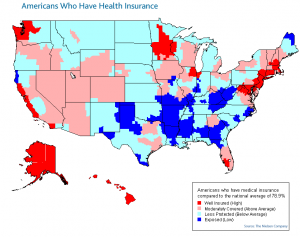 The system of medical insurance in the United States can seem rather complicated at first sight. There are different insurance programs and packages for different categories of the population, and they cover different aspects of medical services. If you’ve never faced this system, you can easily get lost in it.
The system of medical insurance in the United States can seem rather complicated at first sight. There are different insurance programs and packages for different categories of the population, and they cover different aspects of medical services. If you’ve never faced this system, you can easily get lost in it.
But, in fact, all you really need to know is the names of some key, insurance programs and their features.
First of all, it is necessary to understand that ordinary, state, insurance programs do not cover all the expenditures for medical services and drugs. Mostly, they cover a limited amount of essential drugs.
All the rest of the medicines are paid for by you. For example, if you hope to get a free Cialis coupon under your insurance program’s terms, you’ll be disappointed, as Cialis is not an essential drug. Medicines are expensive in the U.S., and for most of them the citizens pay from their own pocket.
Medicare
Medicare is the best-known and the most popular American, federal insurance program. It is mostly oriented to elderly (people older than 65) and the disabled. It doesn’t cover 100 percent of the citizens’ expenditures on medical services, but it is still broadly used throughout the country as it helps to save on drug costs substantially. This program doesn’t cover dental care, eye exams, and treatment of sexual disorders, such as erectile dysfunction. So, men have to buy generic Cialis and eye drops and pay out of their own pocket at any age or pay for additional services.
Medicaid
 This is a social program for the poorest people. Those who enroll for this program’s coverage have to undergo an income assessment. It helps those people who can’t pay for essential drugs and services by themselves. Of course, it also doesn’t cover medications above what are essential, and drugs for the treatment of eye disorders and erectile dysfunction are bought by patients themselves irrespective of the cost of Cialis and its analogues.
This is a social program for the poorest people. Those who enroll for this program’s coverage have to undergo an income assessment. It helps those people who can’t pay for essential drugs and services by themselves. Of course, it also doesn’t cover medications above what are essential, and drugs for the treatment of eye disorders and erectile dysfunction are bought by patients themselves irrespective of the cost of Cialis and its analogues.
SCHIP
Another state (federal) insurance program has been developed especially for children for those families that are not covered by Medicaid, but still can’t afford paying for an expensive, private program. As the name implies, this state program covers the needs of children for essential medications.
Private Insurance Programs
 Of course, apart from state-sponsored insurance plans, every individual can buy any private plan on his own. But more frequently, it is bought by employers, as a group package, which is distributed between the employees. Many plans from employers cover not only employees, but their families as well. Most adult Americans are covered with this particular type of medical insurance. Terms of different employer-sponsored types of health coverages can differ greatly depending on the size of the company, form of ownership, and other aspects.
Of course, apart from state-sponsored insurance plans, every individual can buy any private plan on his own. But more frequently, it is bought by employers, as a group package, which is distributed between the employees. Many plans from employers cover not only employees, but their families as well. Most adult Americans are covered with this particular type of medical insurance. Terms of different employer-sponsored types of health coverages can differ greatly depending on the size of the company, form of ownership, and other aspects.
Also, there is a special type of medical insurance for students. These plans are partially sponsored by colleges or universities.
Finally, any individual can purchase any private, medical insurance. The percentage of such self-insured citizens in not large, but still this phenomenon exists.
Some Americans are not covered by any state or private insurance program, but their number is moderate. The U.S. is a country where medical services are the most expensive in the world. If you are healthy, you are lucky. But if you happen to get ill or get into an accident, you are liable to spend a fortune on recovering if you are not covered with a medical, insurance program.
